vibbzlab
Hazard to Others
  
Posts: 241
Registered: 6-11-2019
Member Is Offline
Mood: Always curious
|
|
Dibenzalacetone - Organic Synthesis writeup
Dibenzalacetone is a pale yellow organic compound which was earlier used in sunscreen because it has the ability to absorb UV light
link to preparation demonstration
https://youtu.be/_BuntAh2Xog
Dibenzalacetone an organic compound formed through the famous aldol reaction called Claisen-Schmidt condensation reaction
Materials required
Sodium hydroxide 3.15g
Benzaldehyde - 3.2ml
Acetone - 2.3ml
Ethyl alcohol - 25ml
Distilled water - 30ml
Ice water bath
Step 1 is to make a solution of sodium hydroxide
Take 3.15g Sodium hydroxide keep it in a 100ml beaker kept in icebath and add 25ml ethyl alcohol and 30ml distilled water to make a solution of it.
Allow it to cool in ice bath.
Step 2
In a seperate 50ml beaker mix together 3.2ml benzaldehyde and 2.3ml acetone.
After a thorough mixing we pipette out half of the mixture
Step 3
Transfer the pipetted mixture into the Cooled Sodium hydroxide solution slowly with constant stirring.
by about 1minute a white fluffy precipitate is formed.
continue stirring for another 15minutes
Whats happening here is 2molecules of Benzaldehyde reacts with 1 molecule of acetone on both its alpha carbons
Let us continue.
After 15 minutes add the rest of the mixture of benzaldehyde and acetone and continue stirring gently for 30minutes.
Slowly a pale yellow precipitate forms.
After 30minutes stop stirring and filter the solution to collect the precipitate.
Ice cold water can be used to purify the product.(DBA is insoluble in water)
Further purification can be done by recrystallising usinge ethyl alcohol (DBA is soluble in ethanol)
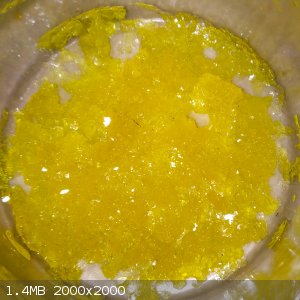 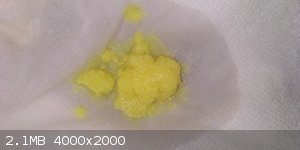
Amateur chemist. Doctor by profession
Have a small cute home chemistry lab.

Please do check out my lab in YouTube link below
This is my YouTube channel |
|
|
Boffis
International Hazard
    
Posts: 1836
Registered: 1-5-2011
Member Is Offline
Mood: No Mood
|
|
Intersting synthesis. Have you tried this with other aromatic aldehydes?
I tried this with cinnamaldehyde, salicylaldehyde, anisaldehyde and vanillin both as disubstituted and mono substituted derivatives and I am still
trying to sort out what was produced. Anisaldehyde reacted as expected, so did cinnamaldehyde but the products are hard to purify, with vanillin I
struggled to identify/purify the product and with salicyladehyde I got two products but with unexpected properties.
|
|
|
vibbzlab
Hazard to Others
  
Posts: 241
Registered: 6-11-2019
Member Is Offline
Mood: Always curious
|
|
i dont have the other aromatic aldehydes. I would definetly love to do the synthesis if i can get my hands on those chemicals
Amateur chemist. Doctor by profession
Have a small cute home chemistry lab.

Please do check out my lab in YouTube link below
This is my YouTube channel |
|
|
njl
National Hazard
   
Posts: 609
Registered: 26-11-2019
Location: under the sycamore tree
Member Is Offline
Mood: ambivalent
|
|
@vibbzlab I have a bit of piperonal with your name on it if you'd like. Might be useful for opening up some positions to substitution?
|
|
|
vibbzlab
Hazard to Others
  
Posts: 241
Registered: 6-11-2019
Member Is Offline
Mood: Always curious
|
|
sorry
didnt quite get you xD.
Amateur chemist. Doctor by profession
Have a small cute home chemistry lab.

Please do check out my lab in YouTube link below
This is my YouTube channel |
|
|
G-Coupled
Hazard to Others
  
Posts: 287
Registered: 9-3-2017
Member Is Offline
Mood: Slightly triturated
|
|
They appear to be kindly offering to send you some Piperonal to do with as you will.
That's nice. 
|
|
|
Bedlasky
International Hazard
    
Posts: 1219
Registered: 15-4-2019
Location: Period 5, group 6
Member Is Offline
Mood: Volatile
|
|
I tried this synthesis recently, I followed up this procedure:
https://www.youtube.com/watch?v=yfy57Gc8VfM
He used EtOH as solvent, I used MeOH instead.
5g NaOH, 50 ml H2O and 40 ml MeOH were mixed. Resulting solution was cool down to room temperature. 5,4 g of benzaldehyde and 1,5 g of acetone were
mixed in separate beaker. NaOH solution was placed in water bath to keep temperature constant. Magnetic stirrer was put on and half of
acetone/benzaldehyde mixture was added in to the NaOH solution. It was left for 15 minutes, then second half of acetone/benzaldehyde mixture was
added. Stirring was kept for 30 minutes. Product was then filtered and washed few times with water to wash out NaOH with some benzaldehyde. Then it
was washed with 40% V/V MeOH precooled to 5 °C to remove rest of benzaldehyde.
Dibenzalacetone was put in to the beaker with some MeOH and it was heated up. MeOH was added until all of dibenzalacetone dissolved. Then I boiled of
MeOH until product start to precipitate (cca 30 ml of MeOH is needed for saturated solution). Then I added squirt of MeOH to dissolve everything again
and let it cool down to room temperature and than in the fridge to 5°C. However everything solidified in to one mass, so recrystallization from MeOH
was practically useless.
So I heated mixture again, add some more MeOH and add 10 ml of water to decrease solubility of dibenzalacetone. I added MeOH until it all dissolved.
Adding water in to solution of dibenzalacetone in MeOH caused some lumps to precipitate and these lumps dissolved really slowly, so I added too much
MeOH and must boil excess away. I eventually find ideal solvent for recrystallization - 15 ml of water + 60 ml MeOH, then adding MeOH until all solid
dissolve. You obtain cca 100 ml of saturated solution. I let it cool to room temperature and then put it in to the fridge at 5 °C. Product was
filtered and washed with cold 40% MeOH. I tried fuchsin test for aldehydes to see if product is still contaminated with benzaldehyde. I added little
bit of dibenzalacetone in to the beaker, dissolved it in MeOH and added small amount of decolorized fuchsin solution. Solution immediately turned dark
red, indicating that product was still heavily contaminated with benzaldehyde.
So I did second recrystallization, this time fuchsin test give only slightly red solution, which indicates very low contamination with benzaldehyde. I
decided not to do another recrystallization, I even didn't have time for another workup, so I just let the product sit for a few days and let
benzaldehyde to oxidize in to benzoic acid. Then I washed dibenzalacetone with NaHCO3 solution - I heard just weak fizzling, didn't notice any
bubbles. I filtered the mixture, wash solid with some water and let it dry at 105 °C. Yield 2,43 g of dibenzalacetone (40,17 % based on acetone).
Melting point 110-111 °C which perfectly corresponds with literature. The goal was produce very pure dibenzalacetone, because I need it as analytical
standard, so I am glad that it worked (regardless the low yield). Product have weak sweet pleasant smell.
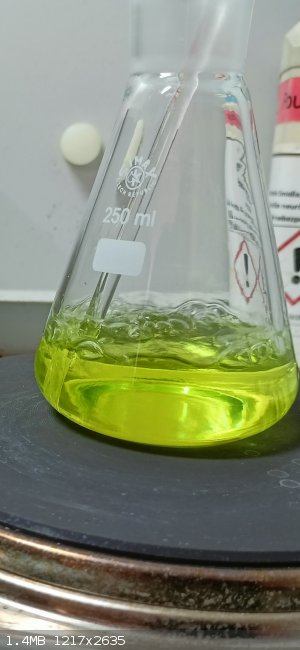
First attempt to recrystallize dibenzalacetone from MeOH.
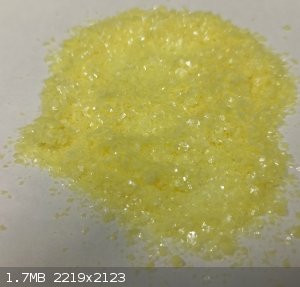 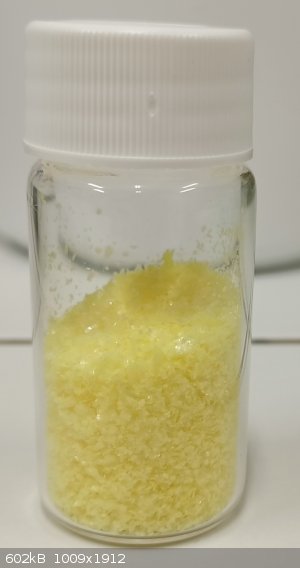
Final product.
[Edited on 23-10-2022 by Bedlasky]
|
|
|
Fery
National Hazard
   
Posts: 990
Registered: 27-8-2019
Location: Czechoslovakia
Member Is Offline
|
|
Hi Bedlasky, nice experiment and very pure product according m.p. You did 3 crystallizations so the yield is good. Clever idea to let the remainders
of benzaldehyde to oxidize by air and convert into water soluble Na benzoate!
|
|
|
arkoma
Redneck Overlord
      
Posts: 1761
Registered: 3-2-2014
Location: On a Big Blue Marble hurtling through space
Member Is Offline
Mood: украї́нська
|
|
There are DEFINITELY some nice folk here.
"We believe the knowledge and cultural heritage of mankind should be accessible to all people around the world, regardless of their wealth, social
status, nationality, citizenship, etc" z-lib
|
|
|
Bedlasky
International Hazard
    
Posts: 1219
Registered: 15-4-2019
Location: Period 5, group 6
Member Is Offline
Mood: Volatile
|
|
Quote: Originally posted by Fery  | | Hi Bedlasky, nice experiment and very pure product according m.p. You did 3 crystallizations so the yield is good. Clever idea to let the remainders
of benzaldehyde to oxidize by air and convert into water soluble Na benzoate! |
Thanks Fery. I did just 2 recrystallization, the first attempt from pure MeOH was unsuccessful, because everything turned in to one solid mass.
|
|
|
Pumukli
National Hazard
   
Posts: 686
Registered: 2-3-2014
Location: EU
Member Is Offline
Mood: No Mood
|
|
Nice colours! 
I'd like to suggest that besides the masses of used reagents a molar equivalent of these masses should also be indicated in synthesis descriptions.
Something like this: "5 g NaOH (125 mmol)". So the molar ratios of reagents could easily be calculated.
I'm curious if you would let us know what kind of "analytical standard" is in the making? 
|
|
|
Bedlasky
International Hazard
    
Posts: 1219
Registered: 15-4-2019
Location: Period 5, group 6
Member Is Offline
Mood: Volatile
|
|
I want to try titrations with BrCl and IBr solutions in chloroform. So I need some pure alkene.
I also read about complex of dibenzalaceton with Pd(0), I can try to make some (in mg scale).
[Edited on 23-10-2022 by Bedlasky]
|
|
|
Bedlasky
International Hazard
    
Posts: 1219
Registered: 15-4-2019
Location: Period 5, group 6
Member Is Offline
Mood: Volatile
|
|
I tried this synthesis once again but this time once again, but this time on 10 times bigger scale. Procedure was the same, 2 recrystallizations
(solvent compositions was little bit different - 50 ml of water + cca 500 ml of MeOH), I let sit product for a week to let oxidize traces of
benzaldehyde by air, benzoic acid was washed out with NaHCO3 solution (5 g NaHCO3/200 ml water). I kept both filtrates after recrystallization for
some further work-up, I wanted to evaporate part of the solvent from filtrate after second recrystallization to obtain some more product and then
leftover combine with filtrate after first recrystallization and precipitate more product by addition of water. But sadly I have little accident and
some water came in to the filtrate after second recrystallization before evaporation, so I combined everything and precipitate dibenzalacetone with
water. But precipitate was too fine and cloged my glass filtration funnel. I tried extraction with chloroform, but this also didn't end up well. So
final yield is 29,05 g of dibenzalacetone, which is 49,6% yield.
|
|
|